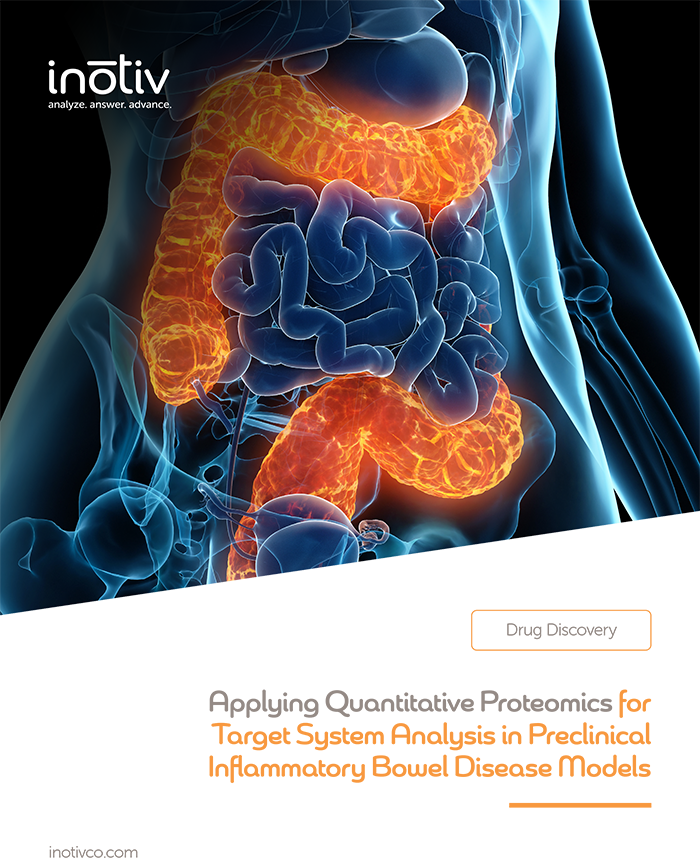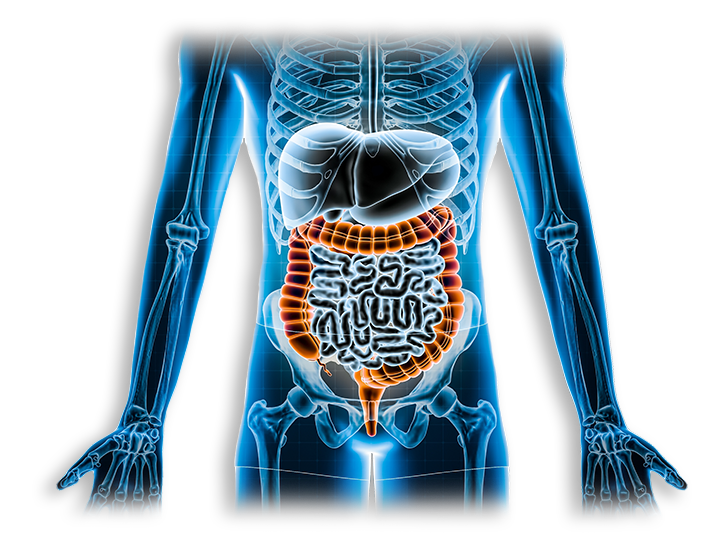IBD Models
Translational In Vivo Models and Disease Pharmacology Services for Drug Discovery

Inflammatory bowel disease (IBD), including Crohn’s disease and ulcerative colitis, affects millions worldwide. Though its exact causes remain unclear, genetic and immune factors play a role. Targeted therapies are essential to address IBD’s chronic nature and complex symptoms.
IBD models, including the DSS-induced colitis and adoptive T-cell transfer models, provide critical insights into disease mechanisms and are invaluable for evaluating the in vivo efficacy of new therapies. Inotiv offers IBD models that closely replicate the clinical features of IBD, along with in vivo pharmacology services to generate accurate efficacy data and optimized disease pharmacology outcomes.
ADOPTIVE T-CELL TRANSFER MODEL
Model Summary
The adoptive T cell transfer model involves transferring T cells from widtype donor mice into immunodeficient recipient mice, inducing colitis. T cells are isolated from the spleens of donor mice and transferred into recipient mice, where they home to the gut and initiate an inflammatory response, resulting in symptoms resembling human IBD. This IBD model enables researchers to study the role of T cells in IBD pathogenesis, investigate potential therapeutic targets, and assess the in vivo efficacy of novel treatments within in vivo pharmacology studies.
Validation Data

Colon weight per length measurements collected at necropsy for normal controls (orange bar; n=5), Rag2 KO mice restored with naïve T cells (red bar; n=10) and Rag2 KO disease models treated with an anti-IL-12p40 monoclonal antibody (grey bar; n=10) in a 7-week study.

Distal colon section from an adoptive T cell transfer model stained with H&E. Section shows severe inflammation with minimal gland loss. M identifies the most severely affected area of mucosa. E identifies edema.
DSS-INDUCED COLITIS MODEL
Model Summary
In the DSS-induced colitis model, mice or rats are exposed to dextran sulfate sodium (DSS) via their drinking water, which disrupts the epithelial barrier of the colon, leading to mucosal damage and inflammation. This disruption triggers an acute inflammatory response characterized by symptoms such as weight loss, diarrhea, rectal bleeding, and histological changes in the colon that resemble human ulcerative colitis. The severity of colitis can be modulated by adjusting the concentration and duration of DSS exposure. DSS can be administered acutely and chronically, with the chronic model offering the added advantage of inducing robust fibrosis, allowing researchers to study disease pharmacology and pathogenesis and to evaluate in vivo efficacy of potential therapeutic interventions. The DSS-induced colitis model is widely used due to its low cost, rapid disease development, and prevalence in publications over the years, making it an invaluable tool in in vivo preclinical research for IBD.
Validation Data

The percent change of body weight of control animals (orange box; n=10) and DSS-induced colitis mouse models (grey box; n=10) throughout a 10-day study.

Distal colon section from a DSS-induced colitis mouse model stained with hematoxylin & eosin (H&E). Section shows severe inflammation with moderate gland loss. Arrow identifies area of erosion. M identifies the most severely affected area of mucosa. E identifies edema.
IL10 KO SPONTANEOUS COLITIS MODEL
Model Summary
The interleukin-10 (IL10) knockout (KO) spontaneous colitis model is frequently used to investigate the development of spontaneous colitis, offering insights into IBD pathogenesis. IL10 is a critical anti-inflammatory cytokine that maintains gut immune homeostasis. Deletion of IL10 disrupts this balance, leading to mucosal immune dysregulation, which triggers inflammatory responses to gut microbiome antigens and results in chronic colitis characterized by Th1/Th17-type immune responses and associated pathological features. The IL10 KO spontaneous colitis mouse model is an effective tool for understanding IBD disease pharmacology and for evaluating in vivo efficacy of potential therapies, providing insights into immune signaling pathways and drug efficacy.
Validation Data

Changes in body weight from study day 0 to study day 56 for normal controls (orange bar; n=15) and IL10 KO spontaneous colitis models treated with either vehicle (red bar; n=12) or an anti-IL12p40 monoclonal antibody (grey bar; n=15).

Colon weight per length measurements collected at necropsy for normal controls (orange bar; n=15), and IL10 KO spontaneous colitis models treated with either vehicle (red bar; n=12) or an anti-IL12p40 monoclonal antibody (grey bar; n=15).
ANTI-CD40 COLITIS MODEL
Model Summary
The anti-CD40 colitis model is an in vivo model used to induce colitis in RAG2 knockout (KO) mice. In this in vivo model, mice are administered antibodies targeting CD40, a co-stimulatory molecule expressed on immune cells such as dendritic cells and macrophages. By blocking CD40 signaling, this model disrupts immune homeostasis and promotes gastrointestinal inflammation. This inflammatory response is characterized by symptoms such as weight loss, diarrhea, rectal bleeding, and histological changes in the colon resembling those seen in human IBD. The anti-CD40 colitis model serves as a valuable tool in disease pharmacology for studying the immunological mechanisms underlying IBD pathogenesis and evaluating in vivo efficacy of potential therapeutic interventions.
Validation Data

Weights of colons collected at necropsy from normal controls (orange bar; n=8), Rag2 KO mice given anti-CD40 IgGa monoclonal antibodies to induce acute ulcerative colitis (red bar; n=8), and Rag2 KO disease models treated with an anti-IL-12p40 monoclonal antibody (grey bar; n=8). *p<0.05 student’s t-test compared to disease control.

Colon section from an anti-CD40 colitis model stained with H&E. Section shows moderate inflammation and mild gland loss. M identifies the most severely affected area of mucosa. E identifies edema.
TNBS-INDUCED COLITIS MODEL
Model Summary
The TNBS (2,4,6-trinitrobenzenesulfonic acid) induced colitis model is a well-established IBD model that mimics aspects of human ulcerative colitis. TNBS activates various immune cell types, including T cells, macrophages, dendritic cells, and neutrophils, inducing colonic inflammation characterized by intense hyperemia, edema, and gut wall thickening. This in vivo model of human IBD, which can be generated in mice or rats, is widely used in preclinical research to understand the mechanisms underlying IBD pathogenesis and to evaluate potential therapeutic interventions. The TNBS-induced colitis model enables researchers to test the in vivo efficacy of novel drugs, assess immune responses, and explore molecular pathways involved in intestinal inflammation, providing valuable insights for the development of new therapies targeting IBD.
Validation Data

Section of distal colon from a TNBS-induced colitis model stained with H&E. Ed identifies edema. * identifies gland loss. Arrow identifies an area with necrosis.
INDOMETHACIN-INDUCED CROHN'S MODEL
Model Summary
The indomethacin-induced Crohn's model involves the administration of indomethacin, a nonsteroidal anti-inflammatory drug, to induce intestinal inflammation in in vivo models. Indomethacin increases mucosal permeability and causes injury and inflammation in the small intestine. By inducing inflammation through non-immunological mechanisms, the indomethacin-induced Crohn’s model complements other IBD models by providing insights into both immune-mediated and non-immune-mediated pathways of intestinal inflammation. This IBD model is essential for understanding IBD pathogenesis and developing novel therapeutic interventions targeting disease pharmacology.
Validation Data

Small intestines collected at necropsy from normal controls (orange bar; n=4), indomethacin-induced Crohn’s rat models (red bar; n=10), and Crohn’s models treated with budesonide (0.02 mg/kg; grey bar; n=10) or dexamethasone (0.1 mg/kg; white bar; n=10) were scored on a scale of 0-5 for gross lesions, with 0 = normal and 5 = severe intestinal lesion resulting in death.*p<0.05 student’s t-test comparison to disease model.

Section of small intestine (jejunum) from an indomethacin-induced Crohn’s model stained with H&E. Arrow identifies an area with necrosis.
Not seeing the model you need? Explore our models for acute small intestinal enteritis or contact us to discuss developing a new IBD model for your preclinical research program.
On-Demand Webinars
Histopathological Assessment of IBD Models
Histopathology plays a pivotal role in therapy development for intestinal inflammation, offering critical insights into disease pharmacology by assessing the severity of inflammation and tissue damage. This information aids researchers in understanding the underlying pathological mechanisms driving IBD and in evaluating in vivo efficacy of potential therapies.
To evaluate IBD models, including DSS-induced colitis and adoptive T-cell transfer models, intestinal sections are stained and analyzed. For each region of the colon (proximal and distal), three equidistant pieces are collected, embedded in paraffin, and stained with hematoxylin & eosin. Each piece is evaluated individually by a board-certified veterinary pathologist for key parameters such as inflammation, gland loss, erosion, hyperplasia, and mucosal lymphoid aggregates. Values are then averaged separately for the proximal, distal, and total colon.
Learn more about our histology services.
Additional IBD Study Endpoints
Should further studies be necessary for evaluating your therapeutic, we offer a range of in vivo, in vitro, and ex vivo assays to generate key data. You may select your preferred endpoints or collaborate with our team of specialists to tailor the project to fulfill your in vivo efficacy and discovery PK requirements.
- Cytokine and chemokine analysis via Luminex® and ELISA
- Mass spectrometry proteomics
- Immunohistochemistry and image analysis
- Bioanalysis and pharmacokinetic services
- CBC/clinical chemistry analysis
- Soft tissue collection
- Immunoprofiling via flow cytometry
Download our IBD/proteomics case study to see how proteome analyses of tissue from IBD models can unveil the systemic effects of therapeutics and provide critical new data to connect in vivo pharmacology studies with human disease.






